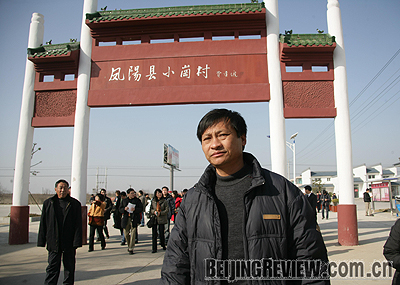|
|

WHERE IT BEGAN: Shi Xueliang, Secretary of the Party Committee of Xiaogang, stands in front of the village entrance (WANG XIANG) | "The annual income of our family now surpasses 10,000 yuan ($1,460). It is much better than in the past," said Yan Lihua, a 60-year-old farmer, standing in the living room of his newly-built two-storied apartment. More than 30 years ago, Yan made a living by begging, before later becoming a star in the agricultural reform of China.
One night in 1978, 18 farmers from Xiaogang Village, in Fengyang County, Anhui Province, pressed red fingerprints onto a contract that assigned areas of land and facilities across the village to individual households. That is a bold and daring move that paved the way for rural reform across the country.
Data displayed in Xiaogang Village Memorial Hall shows that in 1979, one year after the introduction of the household contract responsibility system, the average annual income of residents was 400 yuan ($58), 18 times that of 1978. Also in 1979, the grain yield of the village, which had only 115 people, reached 66,500 kg, four times the average annual yield in the previous 10 years.
The success of Xiaogang Village was a model for other parts of China, and the household contract responsibility system soon spread. In 1982, the "household contract responsibility system" was formally identified as the economic system in rural areas of China.
Under the political background of 1978, the 18 farmers who signed the contract took an enormous gamble, facing the risk of being accused of becoming capitalists and being sent to prison. When they signed the contract, they also made another pledge to each other: if the authorities take away any villager, the others would raise their children until they are 18 years old.
Yan is one of the 18 farmers who signed the contract and his house is where the historic event took place.
Mushroom economy
In 2006, driven by a policy of attracting investment from Fengyang County Government, three college students from Anhui Academy of Agricultural Science and Technology arrived in Xiaogang Village and contracted land to cultivate double-headed mushrooms. In the following two years, they set up a planting base and led villagers to plant mushroom. The planting area has developed from 1.9 hectares in the beginning to 10 hectares now.
"Previously, double-headed mushrooms were used to make exported canned food and had a large market potential," said Miao Juan, one of the three students. Influenced by the financial crisis, the main market for double-headed mushrooms has switched from foreign countries to China, and the total sales volume has not been largely affected.
According to Miao, it is relatively easy to invest in double-headed mushroom cultivation. The annual investment is just 20,000 yuan ($2,919) and the annual profit can reach 10,000 yuan ($1,460), which makes it a suitable industry for many parts of rural China.
"I hope that the mushroom planting industry can benefit more farmers," said Miao.
In May 2008, the Double-headed Mushroom Planting Cooperative of Xiaogang Village was set up. It is organized by local farmers. The role of the cooperative is to purchase raw material and sell products in unity.
"Before the cooperative was set up, the double-headed mushroom market was in a mess, and the benefit to farmers couldn't be ensured. Now conditions have changed a lot," said Guan Zhengyin, head of the cooperative.
|
